Government Feudalism Founded 1238 | 1249–1257 Sri Indraditya 1347–1368 Mahathammaracha I | |
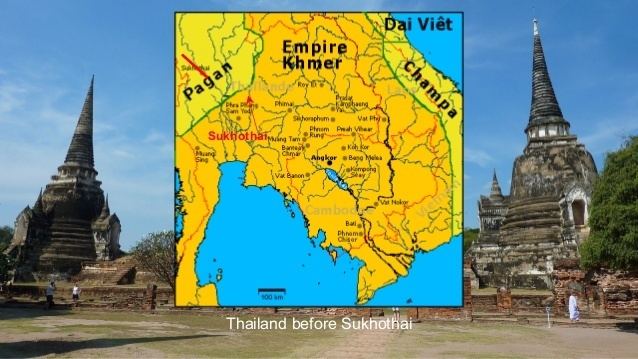 | ||
Capitals Sukhothai Historical Park (1238–1347, 1430–1438), Phitsanulok (1347–1430) | ||
The sukhothai kingdom and its ancient capital
The Kingdom of Sukhothai (Thai: สุโขทัย; pronunciation) was an early kingdom in the area around the city Sukhothai, in north central Thailand. The Kingdom existed from 1238 until 1438. The old capital, now 12 km outside of New Sukhothai in Tambon Mueang Kao, is in ruins and has been designated as a UNESCO World Heritage historical park.
Contents
- The sukhothai kingdom and its ancient capital
- Shorfilm sukhothai kingdom ep 3
- Etymology
- Liberation from Lavo
- Expansions under Ram Kamhaeng
- Decline and domination of Ayutthaya
- Gradual merger with Ayutthaya
- Fall of Sukhothai
- Sukhothai in Thai historiography
- References
Shorfilm sukhothai kingdom ep 3
Etymology
Sukhothai is from Sanskrit sukha (सुख "happiness") + udaya (उदय "rise, emergence"), meaning "dawn of happiness".
Liberation from Lavo
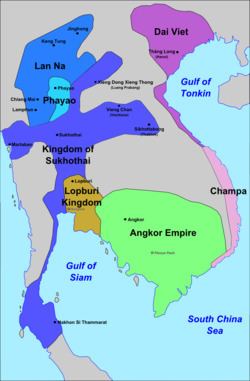
Prior to the 13th century, Tai kingdoms had existed in the northern highlands including the Ngoenyang Kingdom of the Tai Yuan people (centred on Chiang Saen and the predecessor of the Lan Na ), and the Heokam Kingdom of the Tai Lue people (centred on Chiang Hung, modern Jinghong in China). Sukhothai had been a trade centre and part of Lavo (present day Lopburi), which was under the domination of the Khmer Empire. The migration of Tai people into the upper Chao Phraya valley was somewhat gradual.
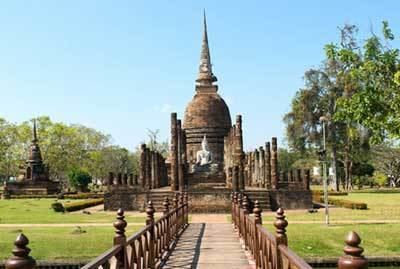
Modern historians stated that the secession of Sukhothai (also spelled Sukhodaya)> from the Khmer empire began as early as 1180 during the reign of Pho Khun Sri Naw Namthom who was the ruler of Sukhothai and the peripheral city of Si Satchanalai (now a part of Sukhothai Province as Amphoe). Sukhothai had enjoyed a substantial autonomy until it was reconquered around 1180 by the Mon people of Lavo under Khomsabad Khlonlampong.
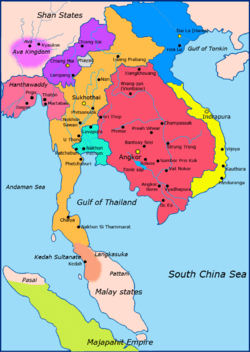
Two friends, Pho Khun Bangklanghao and Pho Khun Pha Mueang revolted against the Khmer Empire governor of Sukhothai. Khun, before becoming a Thai feudal title, was a Tai title for a ruler of a fortified town and its surrounding villages, together called a mueang; in older usage prefixed by pho (พ่อ) "father", (comparable in sound and meaning to rural English Paw). Bangklanghao ruled Sukhothai as Sri Indraditya – and began the Phra Ruang Dynasty - he expanded his primordial kingdom to the bordering cities. At the end of his reign in 1257, the Sukhothai kingdom covered the entire upper valley of the Chao Phraya River (then known simply as Menam, "Mother of Waters," the generic Thai name for rivers.)
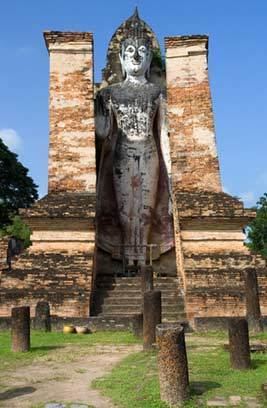
Traditional Thai historians considered the foundation of the Sukhothai kingdom as the beginning of their nation because little was known about the kingdoms prior to Sukhothai. Modern historical studies demonstrate that Thai history began before Sukhothai. Yet the foundation of Sukhothai is still a celebrated event.
Expansions under Ram Kamhaeng
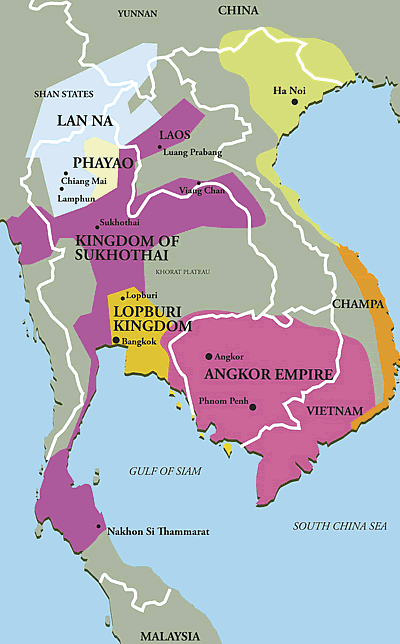
Pho Khun Ban Muang and his brother Ram Khamhaeng expanded the Sukhothai kingdom. To the south, Ramkamhaeng subjugated the kingdom of Supannabhum and Sri Thamnakorn (Tambralinga) and, through Tambralinga, adopted Theravada as state religion. Traditional history described the extension of Sukhothai in a great fashion and the accuracy of these claims is disputed. To the north, Ramkamhaeng put Phrae and Muang Sua (Luang Prabang) under tribute.
To the west, Ramkhamhaeng helped the Mons under Wareru (who is said to have eloped with Ramkamhaeng’s daughter) to free themselves from Pagan control and established a kingdom at Martaban (they later moved to Pegu). So, Thai historians considered the Kingdom of Martaban a Sukhothai tributary. However, in practice, such Sukhothai domination may not have extended that far.
With regard to culture, Ramkhamhaeng requested the monks from Sri Thamnakorn to propagate the Theravada religion in Sukhothai. In 1283, the Thai script was invented by Ramkamhaeng, formulating into the controversial Ramkamhaeng Stele discovered by Mongkut 600 years later.
It was also this time that the first relation with Yuan dynasty was formulated and Sukhothai began sending trade missions to China. The well-known exported good of Sukhothai was the Sangkalok (Song Dynasty pottery) – the only period that Siam produced Chinese-styled ceramics and fell out of use by the 14th century.
Decline and domination of Ayutthaya
By the beginning of the fourteenth century, the Thai of Sukhothai controlled most of present-day Thailand. Only the eastern provinces remained under Khmer control. After the death of Ramkhamhaeng, the Sukhothai tributaries broke away. Ramkhamhaeng was succeeded by his son Loethai. The vassal kingdoms, first Uttaradit in the north, then soon after the Laotian kingdoms of Luang Prabang and Vientiane (Wiangchan), liberated themselves from their overlord. In 1319 the Mon state to the west broke away, and in 1321 Lanna placed Tak, one of the oldest towns under the control of Sukhothai, under its control. To the south the powerful city of Suphanburi also broke free early in the reign of Loethai. Thus the kingdom was quickly reduced to its former local importance only.
In 1349, the armies from Ayutthaya Kingdom invaded and put Sukhothai under her tributary. Then, in 1378, King Luethai had to submit to this new power as a vassal state.
In 1424, after the death of Sailuethai, his sons Phaya Ram and Phaya Ban Muang (Mahathammaracha IV) fought for the throne. Intharacha of Ayutthaya intervened and further divided the kingdom between the two. When Mahathammaracha IV died in 1438, king Borommaracha II of Ayutthaya installed his son Ramesuan (the future king Borommatrailokanat of Ayutthaya) as viceroy of Sukhothai, presumably accompanied by Ayutthayan administrative staff and a military garrison, thus marking the end of Sukhothai as an independent kingdom.
The Silajaruek of Sukhothai are hundreds of stone inscriptions that form a historical record of the period. Among the most important inscriptions are Silajaruek Pho Khun Ramkhamhaeng (Stone Inscription of King Ramkhamhaeng), Silajaruek Wat Srichum (an account on history of the region itself and of Sri Lanka), and Silajaruek Wat Pamamuang (a Politico-Religious record of King Loethai).
Gradual merger with Ayutthaya
It was however not simply annexed and incorporated into the Ayutthayan Empire, rather did the two mandalas and their traditions gradually merge during the 15th and 16th centuries. Sukhothai's warfare, administration, architecture, religious practice and language influenced the Ayutthayan ones significantly. As the Ayutthaya Kingdom did not yet have a centralised administration, the former territories of Sukhothai, now termed as the "northern cities" or Mueang Nuea, continued to be ruled by local aristocrats under Ayutthaya's overlordship. In modern terms, this state may be described as a sort of "federation". The most important "northern city" was now Phitsanulok, as Sukhothai proper had massively lost importance. Northern nobles linked themselves with the Ayutthayan elite through marriage alliances and northern military leaders served prominently in Ayutthaya's army as the military tradition of Sukhothai was considered to be tougher.
From 1456 to 1474, the former territories of Sukhothai were the object of a war between Ayutthaya and the Northern Thai kingdom of Lan Na. In 1462 the city-state of Sukhothai rebelled against Ayutthaya and allied itself with its enemy, Lan Na. During this time, Phitsanulok served as the "second capital" of the Ayutthaya Kingdom, and in 1463 king Borommatrailokanat even moved his residence there, presumably to be closer to the frontline. Contemporary Portuguese traders described Ayutthaya and Phitsanulok as "twin states". Northern nobles descending from old Sukhothai's elite often played the role of kingmakers in Ayutthaya succession conflicts. In 1569 Mahathammaracha, then governor of Phitsanulok and viceroy of the Northern cities, who claimed to descend from the old Sukhothai dynasty, ascended the Ayutthayan throne.
Fall of Sukhothai
After the Battle of Sittaung River in 1583, King Naresuan of Phitsanulok (and crown prince of Ayutthaya) forcibly relocated people from the cities of Phitsanulok, Sukhothai, Phichai, Sawankhalok (Si Satchanalai), Kamphaeng Phet, Phichit, and Prabang to the Southern Central plain, due to the war with the Burmese and an earthquake. After crown prince Mingyi Swa of Burma died in single combat at Don Chedi in 1592, these cities were restored, but not as an independent kingdom, but as provinces within the Ayutthaya Kingdom.
Sukhothai in Thai historiography
Sukhothai story was narrated into Thailand's "national history" in late 19th century by King Mongkut, Rama IV, as a historical work presented to the British diplomatic mission. King Mongkut is considered as the champion of Sukhothai narrative history, based on his find of the Number One Stone Inscription, the 'first evidence' telling the history of Sukhothai.
From then on, as a part of modern nation building process, modern national Siamese or Thai history comprises the history of Sukhothai. Sukhothai was said to be the 'first national capital', followed by Ayutthaya, Thonburi until Rattanakosin or today Bangkok. Sukhothai history was crucial among Siam/ Thailand's 'modernists', both 'conservative' and 'revolutionary'. Rama IV (King Mongkut) said that he found 'the first Stone Inscription' in Sukhothai, telling story of Sukhothai's origin, heroic kings such as Ram Khamhaeng, administrative system and other developments, considered as the 'prosperous time' of the kingdom.
Sukhothai history became important even after the Revolution of 1932. Researches and writings on Sukhothai history were abundant. Details derived from the inscription were studied and 'theorised'. One of the most well-known topics was Sukhothai's 'democracy' rule. Story of the close relationship between king and his people, vividly described as 'father-son' relationship, the 'seed' of Thai Democracy. However the change in ruling style took place when later society embraced 'foreign' tradition, Khmer's Angkor tradition, influenced by Hinduism and 'mystic' Mahayana Buddhism. The story of Sukhothai became the model of 'freedom'. Jit Bhumisak, a 'revolutionary' scholar, also saw Sukhothai period as the beginning of Thai people's liberation movement from foreign ruler, Angkor.
During military rule, from 1950s, Sukhothai was placed in Thai national curriculum. Sukhothai became model of 'father-son' rule, described as 'Thai Democracy', free from 'foreign ideology'; Angkorian tradition compared to communism. Other Sukhothai aspects were investigated seriously, such as commoner and slave status, and economic situation. These topics, said, were on stage of ideological thoughts fighting during the Cold War and civil insurgency times in 1960-1970s.
